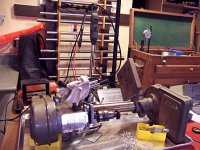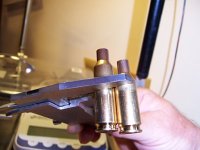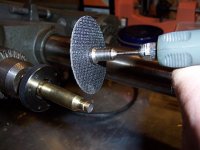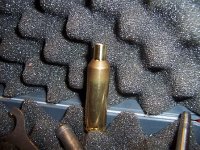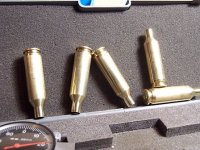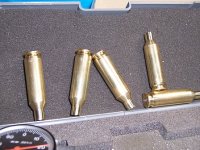Ok, I've got some time so I'm going to try and step-by-step my brass-making program with this cartridge.
Jim asked for it

I may run out of time and have to do this in multiple posts ALA Gene Beggs

I'm not going to number these points because some of them may be out of order. Each paragraph is a separate step.
I'm addressing Jim in particular but I'll try to use terminology which can be understood by beginners too.
This list pertains only to the conversion of the 6.5X47 Lapua case to something I'm calling the 6X47L.
____________________________________________________________
I do NOT sort my cases, just grab up the whole box of brass and load a tray of say 100.
Now I take the time to visually inspect everything under light.
I neck down using a Redding one-piece 6BR FL die WITH the expander ball. I use a polished long-taper "ball", more of a mandrel. (I'm looking for a better way to do this step... pic below of sectioned case shows WHY

look closely at the eccentricity generated. ) Anyway, this is THE important step. I iron out the neck perty good by necking it down and then dragging the ball back through it. Included in this step is setting my crush-fit. Through trail and error I set my die JUST so.....Such that running the case into the 6BR die bumps back the shoulder so that EVERY CASE IS IDENTICAL as far as headspace and EVERY CASE IS IDENTICAL as far as crush fit. And this is why I short-chamber. At this point either you've got to understand just how much pre-figgering goes into this or I've got to spend some time explaining just HOW to make it so that you can do all this. My chamber is so short that I can re-set every case to my specified "crush-factor" just like a PPC...... When the case comes out of this step the headspace is set identically on all of the cases and it's set to TIGHTLY fit the chamber. For a 6X47 that is chambered too long you CAN use the stepped shoulder but it' a crookedy thing! I like to get into the shoulder meat, I prefer it.

___ A CAUTION___
Make absolutely sure that your reamer is ground such that when all is said and done your case fits TIGHTLY at the shoulder and has minimal "gapspace," the clearance at the end of the neck.
IF you push the shoulder back and IF your neck is too long on the case YOU WILL CRIMP ONTO YOUR BULLETS!
BAD juju.....
AT THIS POINT you must somehow KNOW where the end of your neck is. I find this point by using a Sinclair Chamber Length Tool or by cutting a neck back and making a mandrel for it OR I'll cut a caseneck off, take out a section, insert a long FB bullet BACKWARDS and use this to actually MEASURE where my neck ends. I can post pix if need be....... This is important.
Now since this is a brand NEW and for me experimental case I took this whole thing to extreme.

I had my first 6X47L chambered using a 6BR reamer. This results in a neck which had 50 thousandths of gapspace..... NO CHANCE of crimping on the bullet. This was (is) my "Test Mule" (Although it's shooting perty steenking good!) NOW I have had my SECOND barrel made up which is exactly .002 FATTER in the chamber. The first reamer now is my resizing die reamer AND still a great 6BR reamer. My "best" after 6 tries. I now have a monstrous fine fireforming chamber which is EXTRA LONG IN THE NECK so that I can fireform cases, hammer out the necks and THEN turn them to fit my Match chambers. (pic below shows how the 6BR compares and why this can work) ..... but I digress.
___________________________________________________
And......
___ An explanation of "crush fit"____
"Crush fit" for fireforming means that the cases must be LESS THAN ZERO headspace clearance. This aint ABOUT SAAMI Spec GO Gauges. I chamber to an undersized go-gauge. A good crush fit means that you will have to "heel" the bolt closed, nearly bruising your palm. GREASE YOUR LUGS.

In My Opinion a system must be set up wherein one can MAKE the cases to be a crush fit in your chamber. No slop.
____ Back to the program_____
I now have a case which is necked down and ironed out fairly good in the neck and is most likely TOO LONG in the neck!
I ream the inside of the neck with a Wilson reamer. I drive the case using a Lee iris style caseholder mounted in a small tabletop drillpress laid down (pic below)
I run a tightly wound plug of steel wool inside and try to polish it out a little. This step also clears out little chips and such from the reaming. To make this tool I wrap 0000 steel wool around a .22cal brass cleaning brush.
IF the insides clean up to my satisfaction (mine did) I'm now ready to neck turn. IN MY CASE the stock diameter Wilson inside neck reamer produces a fine fit on my Time Precision neckturning mandrel so's I can proceed posthaste.
I neck turn.
I trim to length.
I inside/outside deburr.
I run a K&M long taper reaming tool in to JUST KISS the inside and remove the face burrs.
I again do a polish with the steel wool tools. (pic below)
In the end I come up with a trimmed up case which:
-Fits TIGHTLY into the chamber lengthwise, crush-fit with no endplay at all.
-Fits closely for overall length, small gapspace.
-Is ready to fireform. Incidentally, these cases SHOOT extremely well during fireforming. I'd fireform at a local match if it's at all windy. If it's a trigger pull I'm gonna' try everything possible to go for small group! Screw fireforming.....
______________________________________________________________
Now it's time to fireform.
With this case I've settled on H4350 for 105/107/108/115gr bullets and I currently feel that this powder is "fast" enough for good fireforming. I don't feel the same way about 4831 or RL19 for instance, but that's just me...

If my cases weren't popping out sharply I'd waste a bullet and some barrel and fireform with a 68gr bullet and some faster powder.
But H4350 yields straight, consistent cases so far. ZERO measurable runout after 2-3 firings. All cases feel/resize/seat THE SAME except for a few. This is my first cull, actually more of a "grouping" or "sorting" than a cull......
NOW I can also finally sort by weight etc if I so choose. A perfectionist "weight sorter" would now boil out the cases and weigh them on a bell curve. I don't do this.
My second "cull" also isn't a cull. I sort when resizing by visually identifying the perfectly symmetrical, the slightly offset and the "scrubbed" cases shown earlier. So far I can't see a difference on the target but hey, ya' gots to have SOME method of picking out the "best" cases.
Now after about three firings I get a little weird....... I start paying special attention to seating pressure and I visually re-inspect all of my necks. Sometimes I find one which had a grain of powder lodged in it, or a hunk of steel wool or a chipof brass or a small animal..... maybe a nick. I set out cases which seat a little hard and just touch them up with steel wool a little.... generally I can get most of my initial batch to come into spec, "Perfect Cases."
After 4-5 firings the whole herd just generally comes into line. I might set out a few for "something" but this batch of 6.5X47 Lapua cases has yielded a near perfect batch of cases so far. ONE split shoulder from the factory and that's it. I've got 148 out of 150 usable cases (I wrecked on setting up my neck turner

) "Sorted", but all usable.
OK, I'm sure I've missed a few things or been unclear. Might have even SKIPPED a step! But I'm going to post this just to clear my head.......
Sorry Jim to wait so long to actually sort this out but it's a lot of typing and thinking......
Thanks for waiting
al


